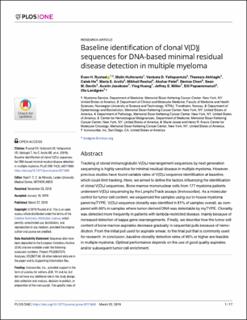| dc.contributor.author | Rustad, Even Holth | |
| dc.contributor.author | Hultcrantz, Malin | |
| dc.contributor.author | Yellapantula, Venkata D | |
| dc.contributor.author | Akhlaghi, Theresia | |
| dc.contributor.author | Ho, Caleb | |
| dc.contributor.author | Arcila, Maria E | |
| dc.contributor.author | Roshal, Mikhail | |
| dc.contributor.author | Patel, Akshar | |
| dc.contributor.author | Chen, Denise | |
| dc.contributor.author | Devlin, Sean M | |
| dc.contributor.author | Jacobsen, Austin | |
| dc.contributor.author | Huang, Ying | |
| dc.contributor.author | Miller, Jeffrey E | |
| dc.contributor.author | Papaemmanuil, Elli | |
| dc.contributor.author | Landgren, Ola | |
| dc.date.accessioned | 2022-05-03T08:21:56Z | |
| dc.date.available | 2022-05-03T08:21:56Z | |
| dc.date.created | 2020-03-19T12:30:44Z | |
| dc.date.issued | 2019 | |
| dc.identifier.citation | PLOS ONE. 2019, 14 (3), 1-17. | en_US |
| dc.identifier.issn | 1932-6203 | |
| dc.identifier.uri | https://hdl.handle.net/11250/2993777 | |
| dc.description.abstract | Tracking of clonal immunoglobulin V(D)J rearrangement sequences by next generation sequencing is highly sensitive for minimal residual disease in multiple myeloma. However, previous studies have found variable rates of V(D)J sequence identification at baseline, which could limit tracking. Here, we aimed to define the factors influencing the identification of clonal V(D)J sequences. Bone marrow mononuclear cells from 177 myeloma patients underwent V(D)J sequencing by the LymphoTrack assays (Invivoscribe). As a molecular control for tumor cell content, we sequenced the samples using our in-house myeloma panel myTYPE. V(D)J sequence clonality was identified in 81% of samples overall, as compared with 95% in samples where tumor-derived DNA was detectable by myTYPE. Clonality was detected more frequently in patients with lambda-restricted disease, mainly because of increased detection of kappa gene rearrangements. Finally, we describe how the tumor cell content of bone marrow aspirates decrease gradually in sequential pulls because of hemodilution: From the initial pull used for aspirate smear, to the final pull that is commonly used for research. In conclusion, baseline clonality detection rates of 95% or higher are feasible in multiple myeloma. Optimal performance depends on the use of good quality aspirates and/or subsequent tumor cell enrichment. | en_US |
| dc.language.iso | eng | en_US |
| dc.publisher | Public Library of Science | en_US |
| dc.rights | Navngivelse 4.0 Internasjonal | * |
| dc.rights.uri | http://creativecommons.org/licenses/by/4.0/deed.no | * |
| dc.title | Baseline identification of clonal V(D)J sequences for DNA-based minimal residual disease detection in multiple myeloma | en_US |
| dc.title.alternative | Baseline identification of clonal V(D)J sequences for DNA-based minimal residual disease detection in multiple myeloma | en_US |
| dc.type | Peer reviewed | en_US |
| dc.type | Journal article | en_US |
| dc.description.version | publishedVersion | en_US |
| dc.source.pagenumber | 1-17 | en_US |
| dc.source.volume | 14 | en_US |
| dc.source.journal | PLOS ONE | en_US |
| dc.source.issue | 3 | en_US |
| dc.identifier.doi | 10.1371/journal.pone.0211600 | |
| dc.identifier.cristin | 1802421 | |
| dc.relation.project | Norges forskningsråd: 223255 | en_US |
| cristin.ispublished | true | |
| cristin.fulltext | original | |
| cristin.qualitycode | 1 | |

